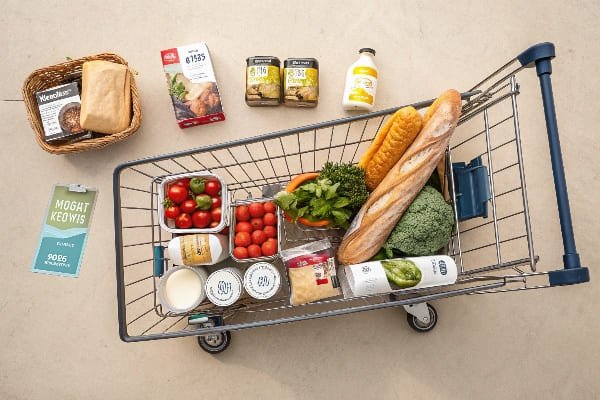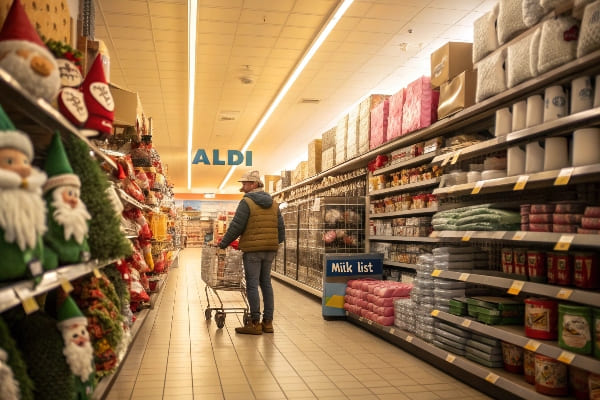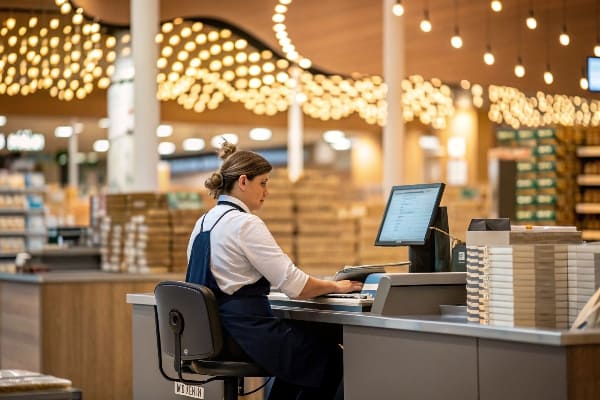I often pack display samples in my carry-on, race to client meetings, and still swing by ALDI because its rhythm feels like a shortcut through grocery chaos.
ALDI is great because it sells a tight mix of private-label basics at rock-bottom prices, moves shoppers fast through smaller stores, and treats efficiency like an art form.

Some people cheer, others roll their eyes, so let us dig under the price tags and see why a tiny German chain can spark such loud opinions.
What is the disadvantage of Aldi?
A shopper walks in hoping for everything on a long list, then learns the product range is lean, the carts need a quarter, and bags cost extra.
The main disadvantage is limited variety supported by a strict bring-your-own-bag model, which saves costs for ALDI but forces shoppers to adapt or shop elsewhere.

How the Lean Model Cuts Both Ways
I grew up near a sprawling hypermarket. It had seven ketchup brands. ALDI offers maybe two. That difference is the heart of both love and frustration.
| Feature | How ALDI Saves Money | Potential Shopper Pain |
|---|---|---|
| Small Footprint | Lower rent, fewer aisles | Fewer specialty items |
| Private Labels | Direct from factories | Brand loyalty clash |
| Paid Bags | Zero bag overhead | Extra planning |
| Quarter Cart Deposit | No staff collecting carts | Minor entry hurdle |
When I fly to meet buyers in Ohio, I notice how quickly locals finish a full shop in ALDI. Fewer choices cut decision fatigue1. Yet a parent needing gluten-free pasta2 must still stop at another store. That second trip erases part of the first trip’s savings. The same tension shows up in my cardboard display factory: narrow SKUs sharpen margins but risk lost orders when a client wants an odd size. ALDI makes the same bet daily, and its managers accept some walkaways in exchange for speed. The chain also hides costs in plain sight: no music, bare bulbs, pallets in aisles. The shopper pays less, yes, but also does a slice of the labor—bagging, returning carts, hunting for specialty goods elsewhere. Accept that bargain and you leave smiling; reject it and you call the system a disadvantage.
Why is Aldi called the Aisle of Shame?
The middle aisle erupts with pet sweaters, blenders, and garden gnomes, singing a siren song to anyone who only wanted milk and bread.
“Aisle of Shame” is a nickname for ALDI’s rotating middle aisle filled with quirky, limited-time finds that lure shoppers into unplanned, sometimes hilarious purchases.

Surprise Merchandising and the Shopper Brain
Impulse displays sit at eye level in my own product world, so I watch ALDI’s middle row like a fellow stagehand. One week a bamboo cheese board appears; the next week, inflatable kayaks bob beside dog treats. Shoppers swap photos in Facebook groups, hunting “unicorns” before they vanish. The scarcity tactic3, borrowed from fashion drops, turns groceries into a treasure hunt.
| Week | Featured Item | Typical Price | Emotional Hook |
|---|---|---|---|
| 1 | Mini Dutch Oven Set | $16.99 | “Cook like a pro” |
| 2 | Weighted Blanket | $24.99 | “Cozy winter vibe” |
| 3 | Outdoor String Lights | $8.99 | “Backyard glow-up” |
| 4 | 3-D Printer Pen | $29.99 | “Craft with kids” |
The “shame” is playful, not literal. Shoppers laugh at themselves for spending $50 on novelty finds while bragging they only meant to grab eggs. ALDI washes its hands of risk by buying limited batches, displaying pallets straight from trucks, and never restocking once they are gone. My own display business mirrors that model during holiday campaigns: fast, thematic, one-shot. The tactic breeds urgency and social chatter, which costs nothing in ad spend. The flip side? Shelf space that once held staples now tempts distraction. Critics claim the center aisle clashes with ALDI’s disciplined identity. But sales numbers show that surprise trinkets grease the margins in a low-price ecosystem.
Why do cashiers sit down at Aldi?
You reach the checkout and find the cashier already seated, scanning at lightning speed while you scramble to keep up with tumbling groceries.
ALDI cashiers sit on ergonomic stools so they can scan faster, reduce fatigue, and keep labor costs low without adding extra staff to each register.

Speed, Ergonomics, and the Quarterback Chair
During a factory audit I once clocked how many cartons an operator seals per hour standing versus seated; productivity climbed 10 %4. ALDI applies the same principle. A seated cashier needs smaller arm motions, stays aligned with the barcode scanner, and can maintain a consistent pace for hours. The chair is not a perk but a component of a broader efficiency system5:
| Element | Purpose | Shopper Impact |
|---|---|---|
| Seated Position | Less fatigue, more speed | Rapid lines |
| Extra-Large Barcodes | Easier scanning | Minimal rescans |
| Cart Swap Model | Items back into cart, pay | No bagging delay in lane |
| Limited Coupons | Fewer exceptions to process | Predictable throughput |
A study in Germany (ALDI’s home turf) found that seated cashiers6 scanned 40 items per minute versus 25 while standing. ALDI multiplied that across 2,200 U.S. stores, trimming millions in payroll. Some customers misread the chair as laziness until they try catching groceries flung into a cart at warp speed. The efficiency lets ALDI run with three or four employees per store, far below industry averages. I admire this as a manufacturer: shave seconds, protect joints, then pass savings downstream. Of course, the pace can feel abrupt. Seniors may feel rushed; first-time shoppers may struggle. Still, the method underpins the price promise. If cashiers stood, turnover might climb, insurance claims might rise, and costs would creep upward, eroding that 49-cent loaf of bread.
Why do some people not like Aldi?
I rave about ALDI on sales trips, yet friends glare and say it feels bare, chaotic, or “too weird” compared with a plush supermarket.
People dislike ALDI when sparse décor, private labels, unusual policies, or limited service clash with expectations built by full-service grocery chains.

Expectations, Habits, and the Service Gap
Grocery shopping is habit. Break that pattern and resistance appears. ALDI breaks many:
| ALDI Practice | Intended Benefit | Possible Dislike |
|---|---|---|
| Own Brands7 | Lower prices | Doubt about quality |
| Bring Your Own Bags8 | Reduce costs, waste | Added hassle |
| Minimal Staff9 | Lean operations | Less help on aisle |
| No Music or Décor | Cheap overhead | Perception of cold atmosphere |
Shoppers who love exploring 40 yogurt flavors feel boxed in by ALDI’s two. Wine enthusiasts miss a sommelier on the floor. Customers used to free samples find none. My client David, who buys crossbows, told me he wants a store that “feels like a hunting lodge.” ALDI’s concrete floors contradict that mood. Still, many complaints trace back to unfamiliarity rather than real flaws. Quality tests show ALDI chocolate ranks near Swiss imports, yet the plain wrapper screams “generic.” It becomes a branding challenge, the same hurdle I face when pitching unprinted, flat-packed cardboard to a luxury-goods firm. Without glossy visuals, they doubt strength—until we load 40 kg and drop test it. ALDI fights the same battle each new shopper. For some, the chain never wins. They crave abundant staff, endless choice, soft lighting. ALDI will not compromise its model to chase them. That divide explains both the fervent fan base and the vocal critics.
Conclusion
ALDI thrives by cutting frills, speeding tasks, and surprising shoppers, yet the very moves that win fans also repel others, proving grocery love is never one-size-fits-all.
Understanding decision fatigue can help you make smarter shopping choices and reduce stress during your grocery trips. ↩
Finding affordable gluten-free pasta options can save you time and money, making your shopping experience more efficient. ↩
Understanding the scarcity tactic can enhance your marketing strategies and boost sales by creating urgency among consumers. ↩
Discover studies and insights on how ergonomic seating can boost productivity in various work settings, including retail. ↩
Learn about the components of an efficiency system in retail and how they contribute to improved operations and customer satisfaction. ↩
Explore how seated cashiers enhance efficiency and customer experience in retail, leading to faster service and reduced fatigue. ↩
Explore how own brands can offer quality and savings, reshaping your grocery shopping experience. ↩
Learn about the environmental and cost benefits of using your own bags while shopping. ↩
Discover the pros and cons of minimal staff in grocery stores and how it affects customer service. ↩

